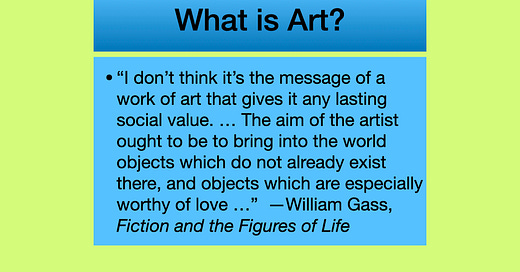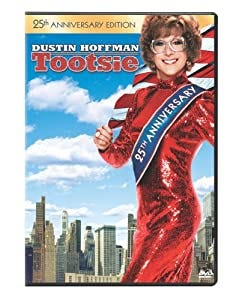Welcome moviewise as guest writer. Before the essay begins, I want to note that the emphasis on a “message” associated with art is one I disagree with—though I love the idea of learning from literature and film. Indeed, as moviewise says at the end, let’s chat about it!
Here is the lovely moviewise’s essay, “The Art of the Screenplay.” And be sure to subscribe to “moviewise: Life Lessons From Movies”:
Image by L.E. Wilson from RedBubble based on definition from Dictionary.com
Bad films, both those that are unskillfully made and those that are not meaningful or significant in any way, can be entertaining. Therefore, neither the ability to entertain, nor the level of entertainment, is a marker of a great film. When one considers the qualities of a great film—not just good and well-made—but great, it becomes clear that there is much more going on than just a pastime or simple entertainment.
These qualities that elevate a bad film to a great one can be summarized quite succinctly by the word “art,” which means that which is beautiful, appealing, or of more than ordinary significance. Note also that the Latin word for "skill" is "ars" or “arte.” Hence we can quickly deduce that skill and beauty are the markers of a great film. Meanwhile, the definition of entertainment is a diversion or an amusement for the mind, which obviously can be just about anything, literally from watching paint dry to studying astrophysics.
To be more precise, we can define a good film as one that is skillfully made in all aspects of the craft: cinematography, editing, sound/music, acting/animation, and in particular includes the writing of a cohesive, internally consistent story that has the ability to elicit emotion, set mood, and guide a reaction. Noting the wide range of things that are entertaining, however, it’s also a given that a skillfully made film will also be entertaining.
But what, then, is a great film? Simply put, a great film is one that possesses all the qualities of a good film, yes including entertainment, and in addition also includes a significant or valuable message. Why a message and not just a visual aesthetic expression of beauty? Because movies, even silent movies, are capable of being more than a moving canvas. The medium is multifaceted, so great movies can and do deliver powerful messages that can induce change in the people watching them. That is no ordinary achievement, and this change in someone’s mind is simply not possible if the message is not there or if it is not clear.
In the “Special Features” bonus section of the movie Tootsie (1982), Academy Award winning director Sydney Pollack explains his initial refusal when asked to direct the movie, by saying: "I can’t direct this. I see you running around in a dress. What’s the spine of this movie guys?" One of the writers, Murray Schisgal, responded by saying, "ahh, I think it’s the story of a person who becomes a man, a better man by having been a woman.”
Tootsie (1982) is a comedy directed by Sydney Pollack about Michael Dorsey/ Dorothy Michaels (Dustin Hoffman), a temperamental, struggling actor who decides to impersonate a woman in order to get a part on a soap opera, then learns firsthand what it is like to be treated like a woman, all while falling in love with a co-star, Julie (Jessica Lange).
Life Lesson: You’ll have more empathy for others if you put yourself in their shoes.
🍿Movie Scene Link (movie quote)
In other words, the marker of a great film is one that integrates within the story a significant, i.e., important, message.
Pollack explains, “I suddenly felt that we’ve come upon something. […] So we started to rethink the picture on that basis. This is the story about a man who becomes a better man by imitating a woman. So now, now certain questions you can ask: In what way does he become a better man, and that makes you say, well, in what way is he not a good man to start with? So now you can dramatize that. Now you have sort of a path to go and it starts to be in the service of something instead of just funny, instead of just jokes.”
Another renowned director who has stated what his intents were in his movies is Andrew Stanton, the director of Finding Nemo (2003), WALL-E (2008), Toy Story (1995).
"When my son was five, I remember taking him to the park. I had been working long hours and felt guilty about not spending enough time with him. As we were walking, I was experiencing all this pent up emotion and thinking 'I-miss-you, I-miss-you,' but I spent the whole walk going, 'Don't touch that. Don't do that. You're gonna fall in there.' And there was this third-party voice in my head saying 'You're completely wasting the entire moment that you've got with your son right now.' I became obsessed with this premise that fear can deny a good father from being one. With that revelation, all the pieces fell into place and we ended up with our story."
Finding Nemo (2003) is an animated fantasy co-written and co-directed by Andrew Stanton about a clownfish father, Marlin (Albert Brooks), and the journey he takes to rescue his captured son, Nemo (Alexander Gould), with the help of a forgetful regal blue tang, Dory (Ellen DeGeneres).
Life Lesson: Don’t always fear the worst; it prevents you from being free to enjoy life.
🍿Movie Scene Link (movie quote)
In brief, a good film that demonstrates skilled filmmaking becomes a great film, a work of art, if it makes the viewer think, i.e., if it has a message to deliver that lingers in the mind. However, a message alone is not enough to elevate a badly made film. In fact, if a movie is crafted badly enough, the message won’t get past all the distractions and errors found in it. Additionally, a bad film—one that does not demonstrate skilled filmmaking or one that has no point or message—can still be entertaining and well-loved. But just because it is enjoyable does not make it great.
Some may argue that ALL movies are art, but this cannot be true because it devalues the meaning of the word art. Art should mean the highest level of skill. It should illustrate unbearable beauty, or be impressive precisely because it’s a demonstration of highly developed skills. To say that all movies are subjective, un-judge-able "art" evades the issue. It also discounts and belittles a whole field of inquiry and scholarship with a long and glorious tradition: film criticism.
But if art is about beauty, and we are trying to objectively define art, then that means we need to objectively define beauty. One way to objectively define beauty is to look at evolutionary psychology / evolutionary aesthetics, which has found that by statistically significant margins, most people, no matter their cultural background, or age, or education, find the same things to be pleasing (baby faces, open landscapes, demonstrations of skill), and the same things to be displeasing (rotten food, venomous animals, amateurish attempts). Therefore, it is the universality that allows one to define those pleasing things as "beauty."
A work then must be highly skillfully made in order to appeal across cultures and across time to make them universal. Once it reaches the level of skill that it can be universal, then this means it is beautiful, and this is when it is art. It is then "great art” when in addition to being beautiful it also has a message, a statement, a communication, a reason for being. It is because some art does have a message—and it therefore stimulates more profoundly—that there needs to be a distinction between art and great art, where art is understood to be an extremely high level of accomplishment in and of itself.
Note also that the message in great films is intentional. It is in the writing, in the direction. It is what drives the story in great films, as directors Sydney Pollack and Andrew Stanton delineated in the quotes above. The message in a movie is not a mere interpretation by a viewer, but a realization that feels like an awakening that was guided by the filmmaker. A meaningful message makes films great because there is resonance either in the storyline itself, that is, the story gives the message, or in the characters who embrace or embody it. Basically, a meaningful message reflects serious thinking about the story by the filmmaker, and it therefore results in a more profound piece of work.
The ability of the filmmaker to relay the message is a skill in itself, and it may actually be the most essential aspect of fine filmmaking and storytelling, since it requires the ability to deftly deliver a well-integrated and clear message without being preachy, boring, or heavy-handed. But there is room for interpretation. It is somewhat subjective as to what the precise message of a movie is or what audiences want it to be. So the viewer may not hit on exactly what the filmmaker intended, but if something valuable and meaningful was gained, then that is an astounding feat and worth the label “great.”
Why define what a great movie is? For the same reason we give labels to plants and categorize animals into species: so that we can understand things better and use our knowledge to progress, to further our capacity, to reach a higher level of excellence. We want students/novices to be able to stand on the shoulders of giants and build upon the great works from the past and present, rather than being left to wade through a huge disorganized pile of information that robs them of their time and may mislead them.
So, for would-be filmmakers and movie fans alike, it’s useful to have a working definition of what the highest level of moviemaking is. And it basically boils down to this: A movie that makes you feel and think about a subject matter is stimulating you more than a movie that does only one of those things, i.e. only feel or only think. Hence, this type of movie is doing more, so it is better. The films that can do that are the great films.
When films do become "great" because they meet the highest standards, then it is difficult to then judge them further, to make lists of which one is greater, etc. It may seem that they can't be compared to each other at all. But perhaps this is the role that the film critic plays: a knowledgeable guide who takes films seriously and considers errors in filmmaking seriously, as well as understands technical innovation, and appreciates the skills involved in making a beautiful illusion.
In sum, a well-made movie that makes you feel and think = great; competent filmmaking = good; incompetent filmmaking = bad. And by the way, a bad film that is incapable of even being entertaining is a scourge, a menace, that robs you of your time and takes away joy, which is why film criticism is a public service profession that can help people avoid wasting their time and money.
Of course, any individual can like or dislike anything based on personal preference. This means it's possible to recognize that a film is "great" but not enjoy it, or that a film is "bad" and enjoy it. And of course that’s ok. That’s life. If we all saw everything the same way there would be no room for art; there would be no room for us.
But if you feel you’ve connected to a movie on a deeper level, then it was probably because of the message you took from it, and if you are interested in finding more movies like that and participating in discussions on great and not so great films, please visit: “moviewise: Life Lessons From Movies.” Let’s chat!
or
Any amount helps and I’ll love you back!











Lovely comment from Rebecca Holden. I would add that, as moviewise says, how the movie is crafted, when well done, gives us art through revelation over the arc of the story. As an example, I recently rewatched with a friend _Fracture_, made in 2007, that stars Anthony Hopkins as Ted Crawford, who shoots his unfaithful wife at the opening, and a much younger Ryan Gosling as Willy Beachum, who plays a district attorney. It's described on Wikipedia as a psychological thriller. My friend, a reporter for a major newspaper, and I, her former creative writing professor, discussed how the screenplay focused on the Gosling character's inability to lie and the Hopkins character's ability to not only lie but tell the truth only as he plotted against that truth. The screenplay is also crafted with layers of the conflict as the battle of wills between these two proceeds. Beachum appears at first to be obsessed with winning, in many ways like his adversary. At the film’s start, Beachum is about to join a well-heeled private law firm and even describes that move as “winning”. Over the arc of the film, Beachum comes up against his inability to lie. He studies intensively the law as the plot thickens and his motivation to win deepens to his desire to ensure that justice will be done. The Hopkins character gets revealed as increasingly manipulative and clever and we get some of his backstory that informs how he became who he is—both successful, perseverant and well-studied. Gosling’s character is also deepened with some backstory. Though the film has a certain slick cleverness, it has stood the test of time because these issues remain so au courant as we watch a manipulative former president’s ability to undermine justice. So, is this film art? On many levels, I would argue that it is, largely, because of the layers of conflict that lead to revelation unstated but instead shown. Brilliant performances also inform: The seasoned actor Hopkins comes up against the much younger and less-seasoned Gosling, whose subtle performance defines his now formidable stardom. Did the writers intend to teach us a lesson or did we learn one from the art of the telling?
Really fascinating post - it’s given me a lot to think about!
‘A movie that makes you feel and think about a subject matter is stimulating you more than a movie that does only one of those things, i.e. only feel or only think.’ Next time I watch a film I’m going to consider exactly what I’m getting out of it and why. :D